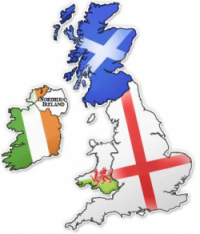Traditional Breakfast Teas of the British Isles

Breakfast teas are black tea blends intended to accompany a hearty, rich morning meal (think of a full English breakfast) and are therefore more robust than afternoon tea blends. Because they are so strong, breakfast teas go well with milk. Breakfast tea blends are usually made with Assam teas, that tend to have higher amount of caffeine.
Since the 18th century the United Kingdom has become one of the worlds greatest tea consumers per capita, with an average per capita tea supply of 1.9 kg per year. Beginning in 1840; British interests controlled tea production in the subcontinent. Tea, which was an upper-class drink at the time, became the infusion of every class in Great Britain during the course of the 18th century and has remained so. While it is usually served with milk, it is not uncommon to drink it black or with lemon, with sugar being the popular addition to any of the above. Strong tea served with milk and usually one to two teaspoons of sugar in a mug, which is commonly referred to as builder’s tea, or brew.
English Breakfast:
Full-bodied and rich. Originally a China black tea now frequently includes a strong Ceylon tea component. Over time blenders incorporated teas grown in India and Sri Lanka as well as Africa and Indonesia. The English started importing Chinese tea in the 17th century and then went into overdrive during the 18th century. For all intent and purposes the first English Breakfast tea was a congou tea.
Once the Opium Wars began, China imposed an embargo on tea. Around the same time, the British East India Company started producing tea in Assam, India. For awhile the old stocks of Chinese tea were dwindling and the new stocks of India tea had begun to arrive, and they were simply blended together. Fast forward to the end of the 19th century and tea was beginning to be produced in Ceylon (Sri Lanka). You started to have a stronger and stronger Ceylon component in English Breakfast tea.
TIDBIT: Some scholars suggest that tea played an important role in Britain’s Industrial Revolution. Afternoon tea possibly became a way to increase the number of hours laborers could work in factories, and the stimulants in the tea, accompanied by the sugary snacks would give workers energy to finish out the day’s work. Further, tea helped alleviate some of the consequences of the urbanization that accompanied the industrial revolution: drinking tea required boiling the water, thereby killing water-borne diseases like typhoid, dysentery, and cholera.
Irish Breakfast:
Generally has a strong Assam component giving it a more robust, and malty flavor. Stronger than that of an English Breakfast. The theory goes that tea must have been growing in popularity in Ireland around the time that the British East India Company was producing tea in Assam.
Scottish Breakfast:
Scottish Breakfast is a full-bodied black tea with a malty flavor best served with sugar and milk, and tends to be the heartiest of the bunch, possibly due to Scotland’s soft water. Back in the day, teas were blended specifically for the water conditions of the areas in which they were marketed and consumed. Its conjecture, but perhaps the water in Scotland demanded a stronger tea. Scotland’s relationship with tea started in the early 1600s, when it was formally introduced to the country. Later, many Scots went to India and Ceylon (Sri Lanka) to form, and operate tea estates. Scotsman James Taylor is known as the father of Ceylon tea.
The Scots helped to make tea into a global drink. Lipton, one of the most recognizable brands, started in Scotland. Thomas Lipton opened his first grocery shop in Glasgow, Scotland, in 1871. After growing his grocery business to over 300 stores, he entered the tea business. Buying directly from growers and even starting an estate himself, Lipton became the first to sell tea to the public at low prices. He was one of the first to create a specific brand of tea that would be the same everywhere it sold. In the 1890’s he expanded his brand to America.
Although the most popular type of tea is English Breakfast, it was actually created in Scotland. According to legend, it was invented in Edinburgh, Scotland, by a Scottish tea master. Queen Victoria, fond of all things Scottish, popularized the blend in England. It eventually became known as breakfast tea. Over the years, companies across the world have copied this tea.
TIDBIT:If you are ever stung by a bee, place a wet black tea bag on the area in which you were stung, and the swelling and pain will disappear rather quickly. The poison is extracted through tannins and acids found within the tea.
Source: travelblog.goaheadtours.com/a-history-of-tea-in-the-british-isles/

